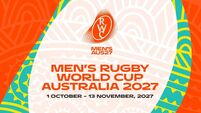Small margins will make a difference for improving Munster

So a draw then. If you’d offered that to most of the fans at Thomond Park Saturday night around the 50th minute, they’d have likely snatched it off you and sprinted off towards the Shannon Bridge.
However, the final whistle brought a palpable sense of disappointment around Thomond Park, almost as if the air had been collectively sucked out of the ground. Racing 92 were outstanding here - one of the best away side performances I’ve seen in Thomond Park since Clermont back in 2014 - but the margins between Munster just about drawing this game and winning it comfortably were relatively small.
People don’t like hearing about small margins in rugby matches. Joe Schmidt mentioned in his autobiography about Ireland’s World Cup failure and, well, you could probably hear the keyboards and touchscreens heating up from outer space. “Small margins” sounds a little too much like excuses to some but in the pressure cooker of top-level rugby, the pass given or not given can be the difference between a line break that wins you the game and a frustrating knock-on that kills momentum stone dead.
JJ Hanrahan’s 89th-minute drop goal miss from just inside the Racing 22 that could well have won this instant classic pool game for Munster isn’t a small margin. That’s just a miss from a guy who, if he was to try it again 19 times would probably make all 19. There’s no cruelty inherent in that statement, it’s just how it is for a player of Hanrahan’s undoubted quality. It was a moment to forget for Hanrahan in a game where the rest of his work was of a really high standard.
The actual small margins are the opportunities Munster left behind in both halves - and there were quite a few. In one way, it’s an encouraging note for the province. These are chances that they weren’t creating in big games last season and, when you consider that this Racing side is the best team Munster has faced since Saracens and Leinster last season and, indeed, Racing themselves in Bordeaux the season before, that is a palpable improvement even if the scoreboard would indicate otherwise.
The biggest improvement was the movement of the ball around Hanrahan when Munster attacked in the phase directly following a hit up by the three-man pod of forwards attacking off Conor Murray as part of Munster’s embryonic 2-3-2-1 attacking forward shape.
There’s a real temptation to get overly wrapped up in 2-4-2s, 1-3-3-1s, and the more contemporary variants but you have to think of any attacking shape as a means to constantly provide attacking options and new pictures to manipulate the defence from ruck to ruck. It’s not about always tipping the ball on or swivelling the ball back to the flyhalf when you get to these scenarios - sometimes you’re going to have to truck it up the middle - it’s about creating the question in defenders’ minds that you could do all of these things - or none of them.
If you get too wrapped up on just the shape, rather than the detail players in the shape are using, then you can end up with a false reading of how Munster are trying to attack.
If you look at last season, for example, Munster were using broadly similar shapes ruck to ruck that they’re using now. The difference is in the variation and that was key here when Munster attacked well.
Two moments stand out in the first half after Russell’s outrageous try in the 18th minute. Munster had four fairly rudimentary carries off #9 that moved Racing across the field until Hanrahan took the ball at first receiver with Farrell acting as a decoy runner on his inside shoulder. Hanrahan had a pod of three forwards on his outside shoulder but stepped back inside against the grain to attack the space that Farrell’s decoy line had opened for him. A clean line break.
Hanrahan popped the ball to Farrell to truck the ball up after the break before buzzing out wide. From there, Murray slung the ball back to Hanrahan, who started a chain of possession from Beirne to O’Donoghue but the last pass to Scannell blew the three-on-one overlap that Munster had created on the outside edge, all from some simple carries coming across the field.
Even that chain of passing from Hanrahan to Beirne to O’Donoghue wasn’t happening in big games last season.
Sure, the last pass from O’Donoghue to Scannell will rankle for a while because just a little more composure at that moment would have lead to an instant retort from Munster, instead of the sloppy concession of a second Racing try less than 10 minutes later that made it 14-6.
In the second half, there were a few more examples of players carrying when they might well have passed. Mike Haley, his generally good performance aside, was guilty of a few moments where, on review, he’ll see the pass as the better option. It’s a small margin. A pass not given. A line not run. My point is, Munster weren’t even getting to these situations last season in these top tier games.
Racing are currently a more cohesive unit than Munster, despite the similarities in coaching changes at both clubs. Munster have more ground to cover to get where they need to be. While they were good in parts here, the overall standard of the performance wasn’t worthy of a win, especially on the defensive side of the ball.
With that said, every game moves Munster a step closer along the road to where they need to be. Disappointments and small margins aside, that has to be encouraging.
- The author is the editor of the Three Red Kings website.















